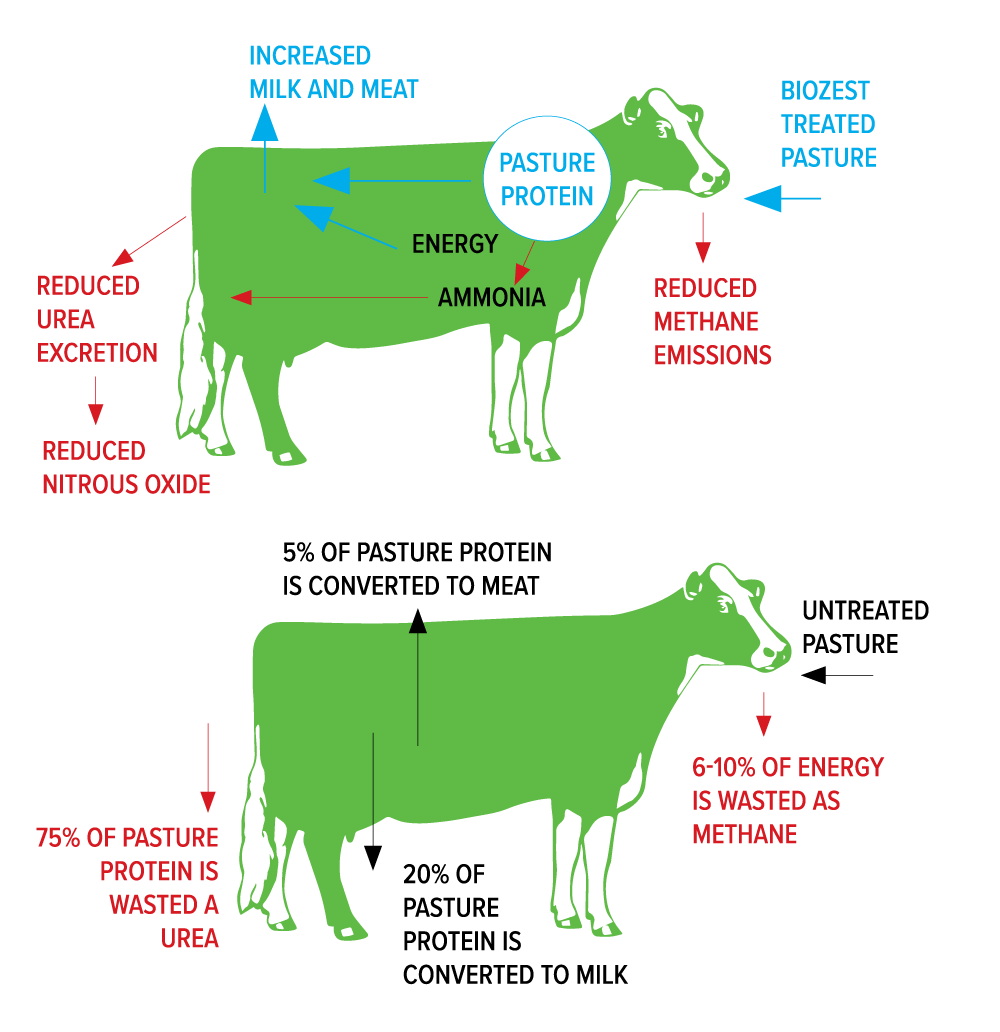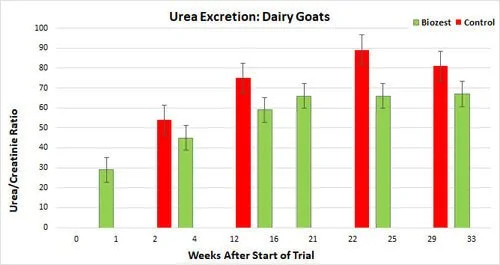Biozest: For Productivity, Resilience & Efficiency
Developed, Tested & Proven on Kiwi Farms
Biozest increases pasture quality, resilience and productivity. Biozest also increases livestock efficiency & productivity.
Key Trial Data:
Increased Kg dry matter/hectare by 89%+
dairy cows grazing on Biozest treated pasture produced 8.5% more milk solids and 12.2% more fat per litre,
bulls gained an extra 22% in weight during a 68-day finishing period.
Biozest is Kiwi owned and has been developed, manufactured and tested in New Zealand by New Zealand farmers, for New Zealand farmers.
Suitable for all farms, including regenerative, biological & organic farms.
New Technology
Backed by Science
Biozest has been extensively tested in multiple districts, seasons, and pasture types. The science, trial methods and results have been published in a peer-reviewed scientific journal https://rdcu.be/cGRgc.
If we want a leap forward in productivity, we can’t just tweak existing products – we need an entirely new technology, and that’s what Biozest is (an elicitor of the phenylpropanoid pathway).
Sheep and cattle convert only 25% of pasture carbohydrate and protein to milk and meat; 75% is wasted through inefficient digestion. When efficiency is as low as 25%, there is huge scope for improvement in milk/meat production.
Biozest increases pasture and livestock production efficiency: converting more resources to pasture, milk and meat. Biozest boosts productivity and results in less waste such as urea/nitrates and methane.
Biozest is the Economically Smart, Climate Smart Solution®.
Cost Effective
Biozest quickly pays for itself and begins increasing farm profits through increased pasture growth, increased milk/meat production and reduced need for imported feed and chemical fertilisers.
Case Study Example: A Waikato dairy farm began using Biozest in 2021. The increase in milk solids production translates to increased earnings of $31,600 over the first 4 months of using Biozest. This farm is 3% up on the previous year while the district is down compared to the previous year.
Buy Now With Confidence
Scroll down for Terms and Conditions
100% Money Back Guarantee*
DATA
For data, case studies, papers and submissions check out our Research Directory
Introduction to Biozest
Biozest is a plant elicitor (or a trigger) it increases plant and animal efficiencies by evoking and strengthening the plant's defence/immune system.
Biozest helps pasture naturally resist stress and damage and improves pasture growth, quality and resilience.
When livestock graze Biozest treated pasture it is more efficiently digested to valuable meat and milk instead of waste products like urea and greenhouse gases.
Technical definition: Biozest is an extrinsic compound elicitor designed to attach to plant membrane bound molecular pattern recognition receptors. Biozest is a molecular pattern recognition receptor signalling compound. - a breakthrough technology which was developed right here in New Zealand.
Biozest is manufactured from plant extracts, fatty acids, plant compatible organic acids and wetting agents.
Biozest has been assessed by MPI and can be applied to all pasture and crops with nil withholding period and nil waiting period. Also suitable for organic production (BioGro #5943).
To find out more, scroll down to read about the science.
Or read our peer-reviewed paper, visit our research pages and scroll through our FAQs for more detailed information.
The Science
How Does Biozest Work?
For detailed scientific information please read the paper published in a peer reviewed scientific journal.
Biozest Increases Pasture Productivity
Biozest is applied to pasture as a liquid spray.
All plants have receptors on their surfaces that detect changes (such as high UV light, pest attack, or disease) and trigger an immune/defence response from within the plant.
Biozest is designed to be detected by these same receptors so that plants respond to Biozest.
This triggers the ‘phenylpropanoid pathway’ - the production of a wide range of bioactive molecules which sustain plant growth and defence systems, assisting plants to overcome stress and damage from pests, disease & environmental effects such as frost or drought.
By producing these bioactive molecules Biozest treated pasture is more resilient, more productive and more palatable.
In this baleage trial, all Biozest treated paddocks, in both the first and second cut, outperformed the untreated paddocks. Overall, the Biozest treated paddocks yielded over 2x as many bales as the untreated paddocks.
2. Biozest Increases Ruminant Efficiency and Milk/Meat Production
Ruminants are inefficient. Only 20-25% of pasture protein is converted to milk or meat. The rest is lost as waste via urine and dung while energy is lost as methane gas.
The bioactive molecules (phenylpropanoids) in Biozest treated pasture protect the protein so more pasture is converted to milk or meat instead of being broken down to ammonia and excreted as urea/nitrates.
Biozest treated pasture also has higher levels of soluble sugars: this favours the production of propionate (which is more efficient and energy rich) over acetate (which is less efficient and results in energy being wasted as methane and heat).
The result: more milk and meat, less gas and urea/nitrates.
This trial was carried out on a dairy farm on the Hauraki Plains. In autumn, gestating cows grazed Biozest treated pasture and untreated pasture in cycles of approximately 8 to 10 days.
Dairy cows grazing on Biozest treated pasture produced 8.5% more milk solids and 12.2% more fat per litre compared to when they were feeding on control (untreated) pasture.
3. Biozest Reduces Environmental Waste
Pollution is the result of wasted resources.
Urea is a loss of valuable protein which may be leached leading to water pollution or converted to the greenhouse gas nitrous oxide. Methane is lost energy. Together, they contribute to increased greenhouse gases and increase farming’s environmental footprint.
Biozest treated pasture increases stock efficiency through enhanced pasture growth, feed digestion and productivity, resulting in a reduction in urea/nitrates and methane.
Urine tests from dairy goats that were fed treated and control pasture in rotation showed that less urea is discharged when the dairy goats are fed Biozest treated pasture. The average decrease in urea excretion is 37% (2-tailed t-test p=0.03). Reducing urea excretion means less nitrates are deposited on the land so less is available to leach to our waterways.

Storefront > Agrizest > Primazest > Biozest > Naturezest
BIOZEST
100% MONEY BACK GUARANTEE!*
*Terms and conditions below.
Pack Size: 5 Litre / 20 Litre Carton
$39.50/Litre excl. GST
Free & Fast Courier Delivery, No Account Required
100% Money Back Guarantee*
Try Biozest on your farm, and if you don’t boost baleage production, we will refund the cost of your Biozest purchase in full.
Our track record of success means we are confident that you will have great results with Biozest on your farm.
You must apply Biozest to 2ha or more and have a comparable block as a control. Data must be supplied.
To sign up to take part and read the trial protocol and full terms and conditions, click here.
Farmer Testimonials
Andrew and Jenny McGiven, Te Aroha.
"I have begun using Biozest this season, and my contract milker and I have been impressed with how our pasture base has thickened, and the plants retained palatability for longer during seed head emergence,"
"We have seen a 3% increase in MS production this season compared to last year which was a record for us.
Stuart Aspin, Taupo
“In combination with a good spring, Biozest helped me to produce an extra 60 tonnes of silage"
It also has animal health benefits because the cows are extracting more from what they were eating.
I used it this year at the start of calving and again midway through calving and I had zero deaths. [It was] such easy calving because of really good animal health.”
Justine Fox, Thames
“Just bailed one of the Biozest paddocks into silage.
The most bales we have ever got out of one of those paddocks is thirty. We just got 45 bales out of it !!
78 bales off the treated paddocks last night compared to my 32 (untreated). Pretty much the same area.”
John and Michelle Cameron, Northland
“If the stock are happy we are happy, The calves have grown rapidly with their mothers’ milk appearing to have a thicker consistency which would seem to be giving better nutritional value. Our pasture appears denser with better nutritional value as well.
Cattle grazing on Biozest treated pasture have averaged 20kg more than those which didn't.”
Jeff Graham, Pukeatua, Waikato
"Biozest is a good product and it has helped us take our milk production from 33,000kg milk solids to 44,000 with the same number of animals.
The goats processed grass more efficiently and lab tests show urea excretion reduced by 37%"
Mike Walsh, Opunake
“Man alive, did I see some results,
Growth was up to 30kg of dry matter a day, compared with 10kg to 15kg normally.
"The grass just took off. Everything grew, clovers and all. And the cows ate it all, right down and evenly across the paddock - even the urine and dung patches."
Matt, King Country Dry Stock Farmer
"the (control) lambs and ewes were nowhere near as good a condition as the other mob.
At docking which was 20th September, it was clear to me that the Biozest had definitely made an effect on the condition of both the ewe and lambs."
Biozest Spray Programme
The application rate is 1 litre of Biozest ($39.50+gst per litre) (in 20 to 500 litres of water) per hectare.
For all farms 2 initial treatments are required – this kick starts the plant response.
Dairy
Strategic application programme (dairy):
Apply 2 initial sprays and then only as needed to avoid feed deficits, overcome stress periods such as drought or frost, boost baleage production and generally increase feed quality and quantity.
Typical Strategic programme:
Rate: 1 litre of Biozest (in 20 to 500 litres of water) per hectare.
Initial Treatment: 2 applications 3 to 5 days apart
Follow on treatment: 1 application in spring, summer, autumn and winter.
Additional treatments as required.
We highly recommend Biozest for hay/silage production.
Apply 2 sprays before locking up the paddocks. If a second cut will be made, apply another Biozest spray 3-5 days after the first cut.
Dairy pasture (full programme):
For year round improvement to pasture growth and quality and milk/meat production as well as reducing environmental impact, the full programme is recommended.
Rate: 1 litre of Biozest (in 20 to 500 litres of water) per hectare.
Initial Treatment: 2 applications 3 to 5 days apart.
Follow on treatment: 1 application 3 to 10 days after grazing.
Dry Stock
We highly recommend Biozest for hay/silage production.
Apply 2 sprays before locking up the paddocks. If a second cut will be made, apply another Biozest spray 3-5 days after the first cut.
Dry Stock Farms:
Rate: 1 litre of Biozest (in 20 to 500 litres of water) per hectare.
Initial Treatment: 2 applications 3 to 5 days apart
Follow on treatment: 1 application in spring, summer, autumn and winter.
Stock Finishing Paddocks Only:
Rate: 1 litre of Biozest (in 20 to 500 litres of water) per hectare.
Initial Treatment: 2 applications 3 to 5 days apart
Follow on treatment: 1 application 3 to 5 days after grazing.





















